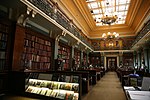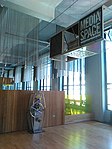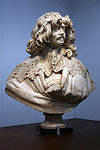Exhibition Road Courtyard

The Exhibition Road Courtyard (named as Sackler Courtyard between 2017 and 2022, then appearing as Exhibition Road Courtyard on maps) is a public courtyard that serves as an entrance to the Victoria & Albert Museum in London. It is part of the V&A Exhibition Road Quarter entrance and expansion of the Museum, completed in 2017 and designed by architectural practice AL_A, the firm of architect Amanda Levete.The courtyard opens out onto the street (Exhibition Road) through a perforated entrance gate. It's made of 11,000 handmade tiles, a reference to the V&A's heritage as a world-leader in ceramic study, collection and preservation. It is the world's first porcelain public courtyard, and special purpose non-slip porcelain tiles had to be created for the project. The courtyard also features a cafe and an oculus, with view down into the new performance hall of the Museum below.
Excerpt from the Wikipedia article Exhibition Road Courtyard (License: CC BY-SA 3.0, Authors, Images).Exhibition Road Courtyard
Courtyard, London Brompton (Royal Borough of Kensington and Chelsea)
Geographical coordinates (GPS) Address Nearby Places Show on map
Geographical coordinates (GPS)
| Latitude | Longitude |
|---|---|
| N 51.4969 ° | E -0.1733 ° |
Address
Courtyard
Courtyard
London, Brompton (Royal Borough of Kensington and Chelsea)
England, United Kingdom
Open on Google Maps









